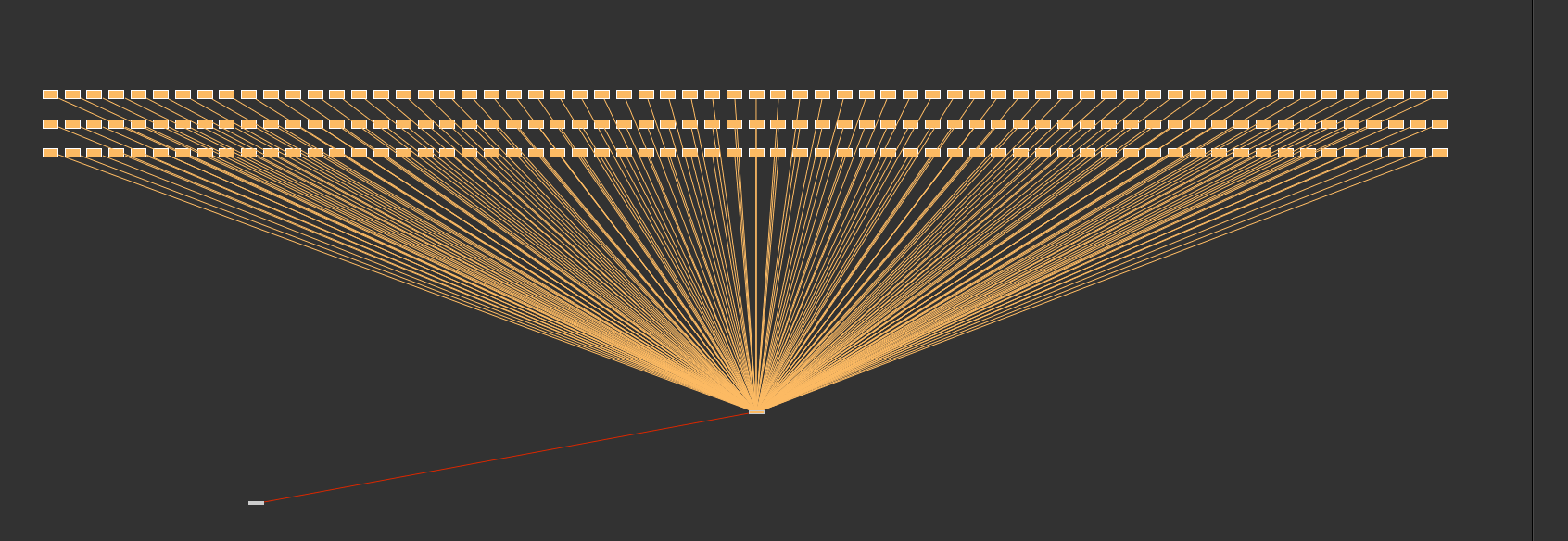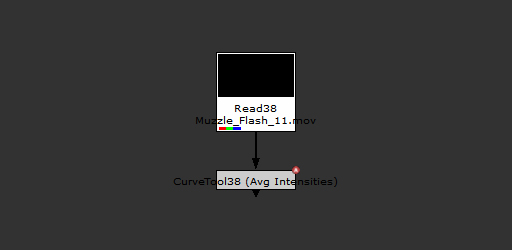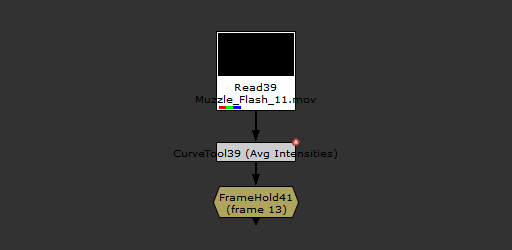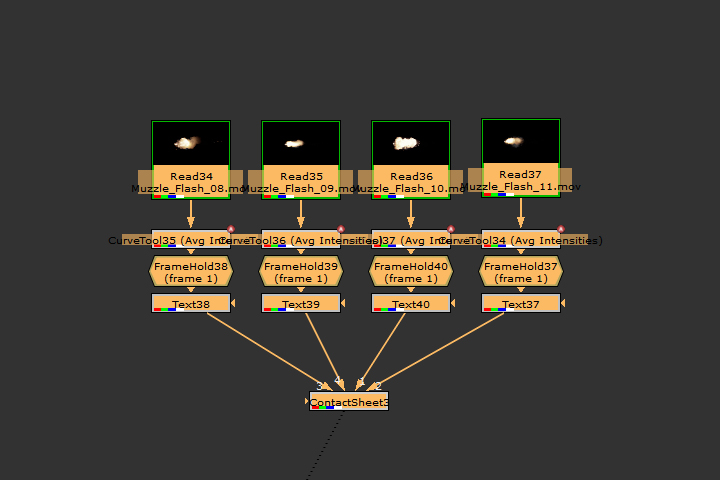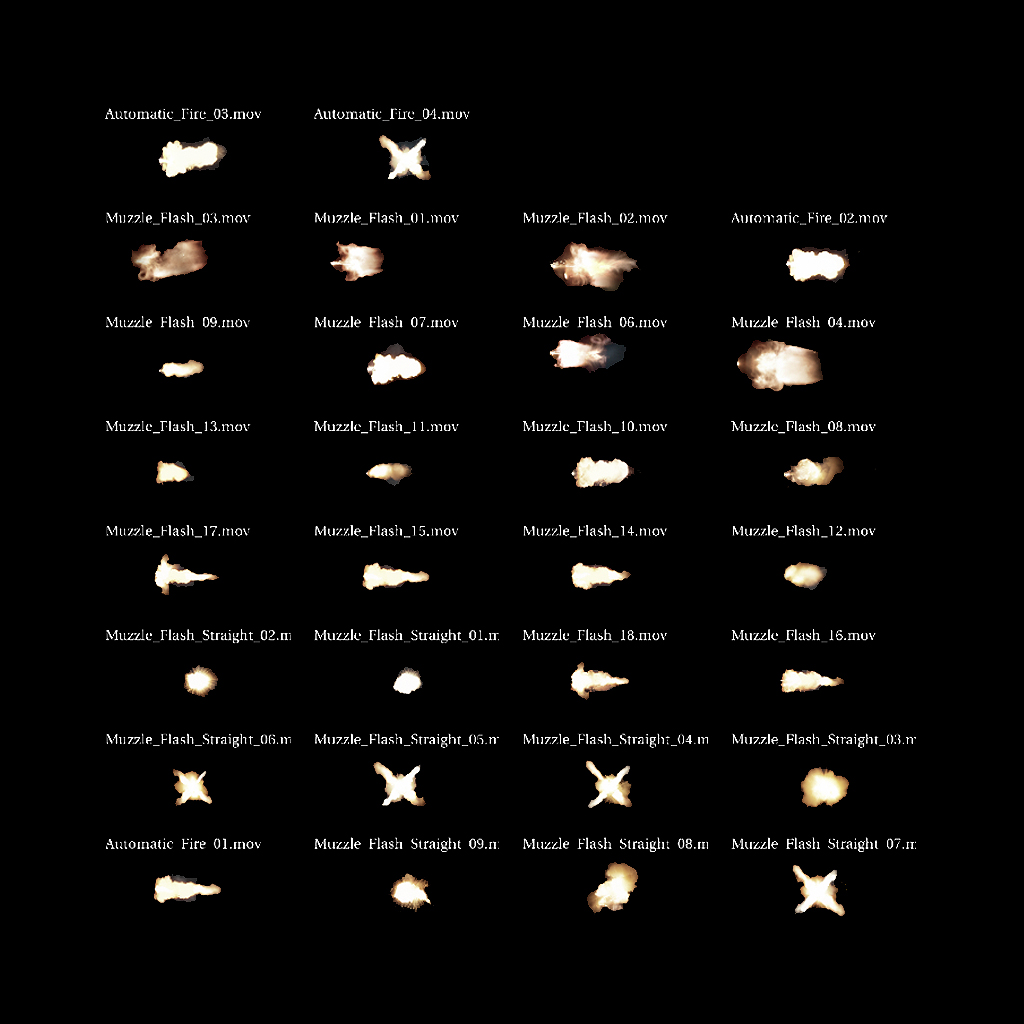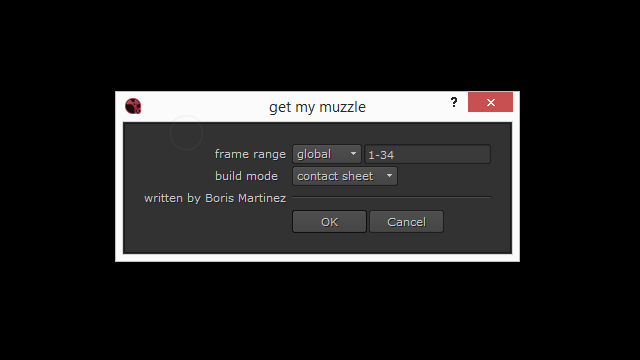MUZZLE FLASH, MY FRIEND
tl;dr: Locate and sort out your muzzle flashes and other stock footage elements quick and easy.
Ok, once one of those guys appear, you would ideally want to lock down the frame where this is happening. For such a thing, you can use a FrameHold Node in Nuke, a timeline marker in After Effects or just take a note on a notebook, to mention a few options. You would continue the same way up until you would have located all the muzzle flashes.
I leave you to reckon with how long any of these approaches would take…
Let´s get this straight. What if you could, just by clicking on a button, automatically build a contact sheet displaying all the different muzzle flash elements there are, therefore enabling you to easily check out the different types, camera angles and so on, and then, once you have built that contact-sheet up, go to any of the individual files and extract all the muzzle flashes in that file?
Well, that, along with other fancy add-ons, is exactly what this script does.
Honestly, this is a fairly simple code. Just a few functions, a class definition to help build a nuke Python Panel, and some global variables. In the form of “pseudo code”, here is the thing:
2 – detect: depending on the so-called “build mode” (I´ll go over this later), it either drops a Framehold node each time a muzzle flash is detected or just one for the muzzle flash that has the maximum luminance intensity, thus locking down either all of them, or just the brightest one.
3 – build: with all detected muzzle flashes locked down with a Framehold node, the script then builds a contact sheet with all of them, and then drops a text node connected to each of the files displaying its name on the screen, automatically.
5 – How to use it.
1 – distribute the code. As we know, when it comes to Python Scripts, we need to be able to import them in Nuke with the command “import module_name”. We can do this either by defining the PYTHON_PATH environment variable or simply by adding within the init.py file the folder structure where we will place our Gizmos, Plugins, Python Scripts and so on, using the command “nuke.pluginAddPath”. If none of this options sound familiar to you, then just drop the script on to the user´s .nuke folder and hope for the best.
– build mode: extract will get all the muzzle flashes in all selected clips. Build will get one muzzle flash per clip, exactly that with the maximum brightness.
important: If you find this usefull, it´s always better to create a Nuke menu from where to call the function.
code
123456789101112131415161718192021222324252627282930313233343536373839404142434445464748495051525354555657585960616263646566676869707172737475767778798081828384858687888990919293949596979899100101102103104105106107108109110111112113114115116117118119120121122123124125126127128129130131132133134135136137138139140141142143144145146147148149150151152153154155156157158159160161162163164165166167168169170171172173174175176177178179180181182183184185186187188189190191192193194195196197198199200201202203204205206207208209210211212213214215216217218219220221222223224225226227228229230231232233234235236237238239240241242243244245246247248249250251252253254255256257258259260261262263264265266267268269270271272273274275276277278279280281282283284285286287288289290291292293294295296297298299300301302303304305306307308309310311312313314315316317318319320321322323324325326327328329330331332333334335336337338339340341342343344345346347348349350351352353354355356357358359360361362363364365366367368369370371372373374375376377378379380381382383384385386387388389390391392393394395396397398399400401402403404405406407408409410411412413414415416#!/usr/bin/env pythonimport nukeimport nukescriptsprint "importing nuke..."print "importing nukescripts..."########################################################################################################################__author__ = "Boris Martinez Castillo"__version__ = "1.0.1"__maintainer__ = "Boris Martinez Castillo"__email__ = "boris.vfx@outlook.com"########################################################################################################################START_FRAME = int(nuke.root()['first_frame'].value())LAST_FRAME = int(nuke.root()['last_frame'].value())def get_file_name(f):return f['file'].value().split('/')[-1]def set_name(n):txt = nuke.createNode("Text2")msg = txt['message'].setValue(n)return txtdef content_finder():SEL = nuke.selectedNodes() # HOLD ALL SELECTED NODESfh_sel_list = []txt_sel_list = []counter = 0for i in SEL:start_frame = i.firstFrame()end_frame = i.lastFrame()print start_frameprint end_framei['selected'].setValue('False') # DE-SELECT CURRENT NODE FROM SELECTION LIST.cv = nuke.createNode("CurveTool")nuke.execute(cv, START_FRAME, LAST_FRAME) # EXECUTES CURVE TOOLif type(get_stop_frame(cv)) == list:for e in get_stop_frame(cv):fh = nuke.createNode("FrameHold")fh.setInput(0, cv)fh['first_frame'].setValue(int(e))label = set_name(get_file_name(i))txt_sel_list.append(label.name())read_recolor(nuke.toNode(i.name()), 112656639)counter += 1print counterelse:read_recolor(nuke.toNode(i.name()), 3238002943)counter += 1if counter == len(SEL):print "txt_sel_list: ", txt_sel_listreturn txt_sel_listdef content_finder_input():SEL = nuke.selectedNodes() # HOLD ALL SELECTED NODESfh_sel_list = []txt_sel_list = []counter = 0for i in SEL:start_frame = i.firstFrame()end_frame = i.lastFrame()print start_frameprint end_framei['selected'].setValue('False') # DE-SELECT CURRENT NODE FROM SELECTION LIST.cv = nuke.createNode("CurveTool")nuke.execute(cv, start_frame, end_frame) # EXECUTES CURVE TOOLif type(get_stop_frame(cv)) == list:for e in get_stop_frame(cv):fh = nuke.createNode("FrameHold")fh.setInput(0, cv)fh['first_frame'].setValue(int(e))label = set_name(get_file_name(i))txt_sel_list.append(label.name())read_recolor(nuke.toNode(i.name()), 112656639)counter += 1print counterelse:read_recolor(nuke.toNode(i.name()), 3238002943)counter += 1if counter == len(SEL):print "txt_sel_list: ", txt_sel_listreturn txt_sel_listdef content_finder_custom(sf,lf):SEL = nuke.selectedNodes() # HOLD ALL SELECTED NODESfh_sel_list = []txt_sel_list = []counter = 0for i in SEL:start_frame = i.firstFrame()end_frame = i.lastFrame()print start_frameprint end_framei['selected'].setValue('False') # DE-SELECT CURRENT NODE FROM SELECTION LISTcv = nuke.createNode("CurveTool")nuke.execute(cv, sf, lf) # EXECUTES CURVE TOOLif type(get_stop_frame(cv)) == list:for e in get_stop_frame(cv):fh = nuke.createNode("FrameHold")fh.setInput(0, cv)fh['first_frame'].setValue(int(e))label = set_name(get_file_name(i))txt_sel_list.append(label.name())read_recolor(nuke.toNode(i.name()), 112656639)counter += 1print counterelse:read_recolor(nuke.toNode(i.name()), 3238002943)counter += 1if counter == len(SEL):print "txt_sel_list: ", txt_sel_listreturn txt_sel_listdef content_finder_int():SEL = nuke.selectedNodes() # HOLD ALL SELECTED NODESfh_sel_list = []txt_sel_list = []counter = 0for i in SEL:i['selected'].setValue('False') # DE-SELECT CURRENT NODE FROM SELECTION LISTcv = nuke.createNode("CurveTool")nuke.execute(cv, START_FRAME, LAST_FRAME) # EXECUTES CURVE TOOLif type(get_stop_frame_int(cv)) == int:fh = nuke.createNode("FrameHold")fh['first_frame'].setValue(get_stop_frame_int(cv))label = set_name(get_file_name(i))txt_sel_list.append(label.name())read_recolor(nuke.toNode(i.name()), 112656639)counter += 1print counterelse:read_recolor(nuke.toNode(i.name()), 3238002943)counter += 1if counter == len(SEL):print txt_sel_listreturn txt_sel_listdef content_finder_int_input():SEL = nuke.selectedNodes() # HOLD ALL SELECTED NODESfh_sel_list = []txt_sel_list = []counter = 0for i in SEL:start_frame = i.firstFrame()end_frame = i.lastFrame()print start_frameprint end_framei['selected'].setValue('False') # DE-SELECT CURRENT NODE FROM SELECTION LISTcv = nuke.createNode("CurveTool")nuke.execute(cv, start_frame, end_frame) # EXECUTES CURVE TOOLif type(get_stop_frame_int(cv)) == int:fh = nuke.createNode("FrameHold")fh['first_frame'].setValue(get_stop_frame_int(cv))label = set_name(get_file_name(i))txt_sel_list.append(label.name())read_recolor(nuke.toNode(i.name()), 112656639)counter += 1print counterelse:read_recolor(nuke.toNode(i.name()), 3238002943)counter += 1if counter == len(SEL):print txt_sel_listreturn txt_sel_listdef content_finder_int_custom(sf,lf):SEL = nuke.selectedNodes() # HOLD ALL SELECTED NODESfh_sel_list = []txt_sel_list = []counter = 0for i in SEL:start_frame = i.firstFrame()end_frame = i.lastFrame()print start_frameprint end_framei['selected'].setValue('False') # DE-SELECT CURRENT NODE FROM SELECTION LISTcv = nuke.createNode("CurveTool")nuke.execute(cv, sf, lf) # EXECUTES CURVE TOOLif type(get_stop_frame_int(cv)) == int:fh = nuke.createNode("FrameHold")fh['first_frame'].setValue(get_stop_frame_int(cv))label = set_name(get_file_name(i))txt_sel_list.append(label.name())read_recolor(nuke.toNode(i.name()), 112656639)counter += 1print counterelse:read_recolor(nuke.toNode(i.name()), 3238002943)counter += 1if counter == len(SEL):print txt_sel_listreturn txt_sel_listdef attach_contact_sheet(l):print "attach_contact_sheet list: ", lall_nodes = len(l)[nuke.toNode(i)['selected'].setValue('True') for i in l]contact_sheet = nuke.createNode("ContactSheet")columns = int(contact_sheet["columns"].getValue())rows = (all_nodes / columns) + 1contact_sheet["rows"].setValue(rows)def read_recolor(l,c):l['tile_color'].setValue(c)returndef get_other_muzzles(l,f,a):for i in l:if i > f:a.append(i)return adef get_frames(anim,value,li):frame = 0for key in anim.keys():x_value = key.xy_value = key.yif y_value == value:frame = x_valueli.append(frame)breakreturn lidef get_stop_frame(node):anim_curve_x = node['intensitydata'].animation(0)y_list = []stop_frame = 0for key in anim_curve_x.keys():x_value = key.xy_value = key.yy_list.append(y_value)y_max_value = max(y_list) # CALCULATE MAX VALUEother_muzzles = []other_stop_frames = []print "max value found: ", y_max_valueom = get_other_muzzles(y_list,0.05,other_muzzles)print "other_muzzles: ",omfor i in om:get_frames(anim_curve_x,i,other_stop_frames)print "other_stop_frames: ", other_stop_framesif y_max_value < 0.05:return Nonefor key in anim_curve_x.keys():x_value = key.xy_value = key.yif y_value == y_max_value:stop_frame = x_valuebreakreturn other_stop_framesdef get_stop_frame_int(node):anim_curve_x = node['intensitydata'].animation(0)y_list = []stop_frame = 0for key in anim_curve_x.keys():x_value = key.xy_value = key.yy_list.append(y_value)y_max_value = max(y_list) # CALCULATE MAX VALUEother_muzzles = []other_stop_frames = []print "max value found: ", y_max_valueom = get_other_muzzles(y_list, 0.05, other_muzzles)print "other_muzzles: ", omfor i in om:get_frames(anim_curve_x, i, other_stop_frames)print "other_stop_frames: ", other_stop_framesif y_max_value < 0.05:return Nonefor key in anim_curve_x.keys():x_value = key.xy_value = key.yif y_value == y_max_value:stop_frame = x_valuebreakreturn int(stop_frame)def main_function():panel = modalPanel()if not panel.showModalDialog():print "script aborted"returnelse:print "script run"if panel.giveFrameRangeValue() == "global" and panel.analysis_mode.value() == "extract" :attach_contact_sheet(content_finder())returnelif panel.giveFrameRangeValue() == "input" and panel.analysis_mode.value() == "extract":attach_contact_sheet(content_finder_input())returnelif panel.giveFrameRangeValue() == "custom" and panel.analysis_mode.value() == "extract":range = panel.frame_display.value()start_frame = int(range.split("-")[0])end_frame = int(range.split("-")[-1])print start_frame, end_frameattach_contact_sheet(content_finder_custom(start_frame,end_frame))returnelif panel.giveFrameRangeValue() == "global" and panel.analysis_mode.value() == "contact sheet":attach_contact_sheet(content_finder_int())returnelif panel.giveFrameRangeValue() == "input" and panel.analysis_mode.value() == "contact sheet":attach_contact_sheet(content_finder_int_input())returnelif panel.giveFrameRangeValue() == "custom" and panel.analysis_mode.value() == "contact sheet":range = panel.frame_display.value()start_frame = int(range.split("-")[0])end_frame = int(range.split("-")[-1])print start_frame, end_frameattach_contact_sheet(content_finder_int_custom(start_frame, end_frame))returnelse:print "pass"return#CREATE A PYTHON PANEL FOR DEALING WITH TIME RANGESclass modalPanel(nukescripts.PythonPanel):def __init__(self):nukescripts.PythonPanel.__init__(self,"get my muzzle")#CREATE KNOBSself.frame_range = nuke.Enumeration_Knob('fRange','frame range', ['global','input','custom'])self.analysis_mode = nuke.Enumeration_Knob('mode','build mode ', ['contact sheet','extract'])self.frame_display = nuke.String_Knob("")self.frame_display.clearFlag(nuke.STARTLINE)self.author = nuke.Text_Knob("written by Boris Martinez")#ADD KNOBSfor i in (self.frame_range,self.frame_display,self.analysis_mode,self.author):self.addKnob(i)#SET KNOB DEFAULT VALUESself.get_frame_range()def giveFrameRangeValue(self):return self.frame_range.value()def get_frame_range(self):if self.giveFrameRangeValue() == "global":first_frame = nuke.root().firstFrame()last_frame = nuke.root().lastFrame()txt = str(int(first_frame)) + '-' + str(int(last_frame))self.frame_display.setValue(txt)elif self.giveFrameRangeValue() == "input":print "here should come the read frame range"node = nuke.selectedNode()first_frame = node.firstFrame()last_frame = node.lastFrame()txt = str(int(first_frame)) + '-' + str(int(last_frame))self.frame_display.setValue(txt)elif self.giveFrameRangeValue() == "custom":self.frame_display.setValue("")print "here the user decides"def knobChanged(self,knob):if knob.name() == "fRange":self.get_frame_range()if __name__ == "__main__":main_function()

